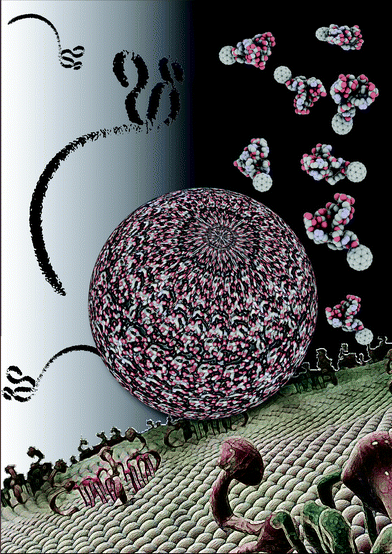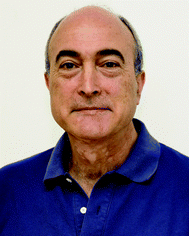Carbon nanostructures in biology and medicine
Nazario
Martín
ab,
Tatiana
Da Ros
c and
Jean-François
Nierengarten
 d
d
aDepartamento de Química Orgánica, Facultad de Química, Universidad Complutense, E-28040 Madrid, Spain
bIMDEA-Nanociencia, Campus de Canto Blanco, E-28049 Madrid, Spain. E-mail: nazmar@quim.ucm.es
cINSTM Unit of Trieste, Department of Chemical and Pharmaceutical Sciences, University of Trieste, Piazzale Europa 1, 34127 Trieste, Italy. E-mail: daros@units.it
dLaboratoire de Chimie des Matériaux Moléculaires, Université de Strasbourg et CNRS (UMR 7509), Ecole Européenne de Chimie, Polymères et Matériaux, 25 rue Becquerel, 67087 Strasbourg, France. E-mail: nierengarten@unistra.fr
Carbon is probably the most important chemical element on earth if we consider that it is associated with the existence of life in our planet. With the advent of the C60 molecule in 1985, the known allotropes of carbon – diamond and graphite exhibiting reticular structures – were extended to a third allotrope formed by fullerenes. Soon afterwards, a variety of new forms of carbon, namely carbon nanotubes (single and multi-wall), endohedral fullerenes (those fullerenes having a chemical species in the inner cavity), carbon nanohorns, carbon nanoonions, so-called peapods, and more recently 2D graphene and the graphene quantum dots and carbon quantum dots have given rise to a new scenario of carbon nanoforms which has powerfully attracted the attention of scientists.
Nanometer-scale carbon structures are the focus of considerable interest since they can be used to test fundamental ideas about the roles of dimensionality and confinement in materials of greatly reduced size. Owing to their peculiar electronic properties, carbon nanoforms have rapidly found applications in the field of materials science. Indeed, fullerenes, carbon nanotubes, graphene and other carbon nanoforms have played a central role in the development of new advanced materials for optoelectronic devices and solar cells. Their derivatives are also at the forefront of the most recent advances in the field of nanotechnology. In contrast, despite the huge interest for a variety of potential applications, the nanoforms of carbon have only scarcely been used for bio-medical applications. This is particularly striking considering that these carbon nanostructures should exhibit a biocompatible behaviour under the appropriate conditions. Actually, their biological applications have been somehow limited by the absence of water solubility and one of the first concerns was related to providing efficient strategies to obtain derivatives with appropriate solubility. Over the years, a plethora of water-soluble carbon nanoforms have been reported and spectacular findings have been described about their biological activity. In the particular case of fullerenes, the initial reports of Wudl on competitive inhibitors of human immunodeficiency virus (HIV) protease by water-soluble functionalized fullerene derivatives has been followed by numerous investigations on anti-viral fullerene derivatives. The special photophysical properties of fullerene derivatives have also been used to generate new sensitizers for DNA photocleavage as well as for photodynamic therapy. On the other hand, polycationic amphiphilic fullerene derivatives have been used as efficient gene vectors in transfection studies. In recent years, hexasubstituted fullerene scaffolds have been used to generate multivalent glycoclusters. Owing to their unique globular shape, these fullerene sugar balls are strong ligands for bacterial lectins thus showing that they are potential anti-adhesive agents against bacterial infection. Moreover, fullerene sugar balls have shown outstanding anti-viral activity in an Ebola infection model thus offering new perspectives for their applications. Finally, when substituted with appropriate glycoside derivatives, significant multivalent effects have been observed for the first time in enzymatic inhibition. This initial observation made with carbon-based derivatives has opened a new field of research and has shown that multivalency is a new tool for innovative drug discoveries. All these aspects of fullerene chemical biology are nicely summarized in a review article by Echegoyen et al. (DOI: 10.1039/c7tb00855d) as well as in a highlight by Ortiz-Mellet et al. (DOI: 10.1039/c7tb00860k).
The tremendous scientific interest initially generated by the biological applications of fullerenes has been rapidly extended to other nanoforms of carbon. Combined with their potential for nanotechnologies, such materials have been extensively used for sensing applications in the field of biology. Carbon nanomaterials are indeed extraordinary platforms for the development of multifunctional systems for imaging, diagnosis, therapy and microsurgery. Their high potential for a wide range of biomedical applications is clearly illustrated in the different review articles collected in this themed issue.
A series of research articles are using the oldest carbon nanostructure (CNS), fullerene, for biomedical applications. Fullerene-based compounds have confirmed their potentiality as inhibitor of viruses, with a new approach toward the emergency of Ebola, and multivalent enzyme inhibition (Fig. 1). On the other hand, functionalization of fullerenes by means of glycol-units presents a double function as solubiliser and as recognition element. Finally C60, with its capability of being photoexcited and, consequently, of generating reactive oxygen species, has great potential as photosensitizer and so far in photodynamic therapy, as reported herein.
 | ||
| Fig. 1 Supramolecular assemblies of glycodendro[60]fullerenes interacting with cell receptors. See Muñoz et al. (DOI: 10.1039/c7tb01379e) | ||
Up to now, the possible use in biology and medicine of carbon nanostructures was mainly focused on carbon nanotubes. In this issue, full papers by Islam et al. (DOI: 10.1039/c7tb00735c) and Heller et al. (DOI: 10.1039/c7tb00695k) show that nanotubes can be used as vectors for drug delivery and their structural characteristics such as diameter, length and functionalization can be tuned to obtain different effects and pharmacokinetics. On the other hand, Criado, Valenti and Prato et al. (DOI: 10.1039/c7tb01557g) developed a highly sensitive electrochemiluminescent detection of prostate cancer biomarkers based on doubly-functionalized multi-wall carbon nanotubes. Finally, a communication of Jedlicka and Rotkin et al. (DOI: 10.1039/c7tb00766c) revealed that their characteristic Raman peaks also allow the identification of the CNTs in cells, with good application for long-term intracellular studies. Furthermore, their fluorescence properties enable their use as optical probes. The latter characteristic is also typical of one of the newest carbon nanostructures, i.e., quantum dots, as shown by Dhara et al. (DOI: 10.1039/c7tb00684e). We can distinguish between graphene and carbon quantum dots, the origin of which is respectively from graphene or various organic sources, that can range from perylene units to tea leaves. Quantum confinement is one element conferring fluorescence peculiarity to these nanostructures, allowing one more time to use them as optical probes or in sensor devices. Their nature consistently differs from other CNSs in terms of water-solubility. In fact, generally, carbon and graphene quantum dots are very soluble thanks to the oxidation processes used to prepare them, with the introduction of carboxylic residues on the surface.
The same superficial functionalization is present on nanodiamonds, but in this case the sp3 core confers different properties but water-solubility. This material finds application in bone and vascular tissue regenerations, when associated to angiopoietin-1, as reported by Krueger et al. (DOI: 10.1039/c7tb00723j), while wound healing can be accelerated in presence of onion derived carbon nanodots as shown by Dhara et al. (DOI: 10.1039/c7tb00869d).
Graphene and graphene oxide derivatives are also studied to prepare materials with antimicrobial activities, but also in this case they are mainly explored as drug vectors, applications common to all the carbon nanostructures so far explored. This is illustrated in contributions from various groups.
As the guest editors of this special themed issue, we firmly believe that it should be a useful tool for specialists in the field as well as a valuable updated reference for the broad readership of non-specialists. The variety of contributions on different topics through original works represents a useful source of information for the reader. We also strongly believe that this issue will further stimulate the imagination and inspiration of scientists working in the fields of carbon nanostructures and biomedical applications.
We would like to thank and express our gratitude to all of the contributors to this fantastic issue, who enthusiastically accepted our invitation to participate in this venture. We would also like to extend our gratitude to all those scientists whose names are cited within the issue for their seminal works. This gratitude is also extended to the Royal Society of Chemistry and, in particular, to the staff of Journal of Materials Chemistry B, for their continuous support and enthusiasm when they heard about our interest in editing this special themed issue.
| This journal is © The Royal Society of Chemistry 2017 |



